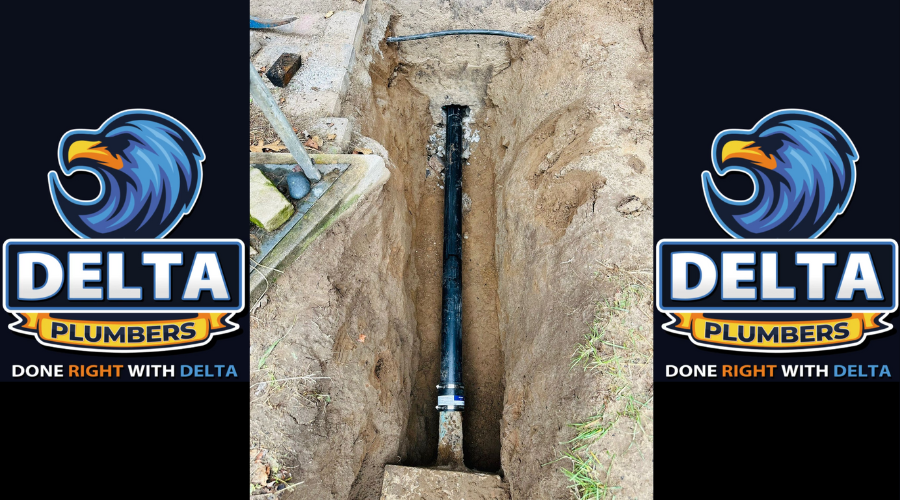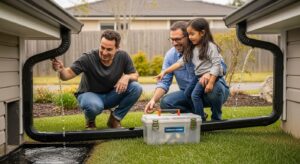In the world of plumbing, sewer line repairs have long been one of the most invasive and disruptive tasks for homeowners. Traditional methods of sewer line replacement often involve extensive digging, and tearing up of landscaping, driveways, and other structures. However, with advancements in technology, trenchless sewer repair has emerged as a revolutionary solution to this age-old problem. This innovative technique allows for the replacement or repair of damaged sewer lines without the need for large-scale excavation, preserving the aesthetics of your property and minimizing disruption to your daily life.
Trenchless sewer repair not only provides a less intrusive alternative to traditional methods but also offers numerous benefits, including cost-effectiveness, reduced repair time, and long-lasting results. This blog explores everything you need to know about trenchless sewer repair, from how it works and the different methods available to its many advantages. Whether you’re facing a clogged sewer line, tree root invasion, or aging infrastructure, trenchless sewer repair may be the future of plumbing solutions that you’ve been waiting for.

Picture Source – Delta Plumbers
What Is Trenchless Sewer Repair?
Plumbing problems can be a major headache, especially when they involve your main sewer line. A damaged or broken sewer pipe often leads to unpleasant disruptions in your daily life, such as slow drains, foul odors, and even potential flooding. Traditionally, repairing or replacing a damaged sewer line meant major excavation, requiring the removal of large sections of your yard, driveway, or even parts of your home. This method not only caused significant disruption to your property but also came with costly restoration fees to return everything to its original state.
However, with the rapid advancement in plumbing technology, trenchless sewer repair has emerged as a groundbreaking solution, providing homeowners with an alternative to the invasive methods of the past. Trenchless sewer repair, also known as no-dig sewer repair, is a modern technique that allows professional plumbers to repair or replace damaged sewer pipes without the need for large-scale digging. By utilizing cutting-edge tools and methods, plumbers can now access and fix underground pipes with minimal disruption to your property, making the process quicker, more efficient, and less costly.
The growing popularity of this method is clear, as more and more homeowners are searching for “trenchless pipe repair near me”. The demand for non-invasive plumbing solutions is on the rise, and for good reason. Trenchless sewer repair offers a wide range of benefits, including faster service, less mess, and the ability to preserve your landscaping and property. But how do these modern techniques work in detail, and is trenchless sewer repair the right option for your home?
Also Read: How to Prevent Basement Flooding in Ontario This Spring

Picture Source – Delta Plumbers
How Does Trenchless Sewer Line Replacement Work?
Trenchless sewer line replacement revolutionizes the way damaged sewer pipes are repaired or replaced by significantly reducing the need for invasive digging and disruption to your property. Unlike traditional methods that require large trenches to expose and replace entire sewer pipes, trenchless technology uses minimal access points to reach the damaged area. This modern approach relies on two primary techniques—pipe lining and pipe bursting—to restore the integrity of the sewer line without the extensive excavation of yards, driveways, or landscaping.
So, how exactly does the trenchless sewer repair process work? Here’s a step-by-step look at how this innovative technology is applied to replace or repair a damaged sewer line:
1. Initial Inspection
The process begins with a thorough video camera inspection of the sewer line. Using specialized cameras inserted into the pipe, plumbers can visually assess the condition of the existing sewer system. The camera feeds live footage to a monitor, allowing the plumber to pinpoint the exact location of the damage, such as cracks, tree root intrusions, blockages, or pipe corrosion. This crucial first step helps determine the extent of the damage and allows plumbers to choose the most appropriate trenchless repair method for the situation.
Video inspection also helps identify any underlying issues that may not be immediately visible, ensuring that the right solution is selected from the start. This inspection can often be completed in a short time frame, allowing for a swift diagnosis and repair plan.
2. Site Preparation
After the inspection, the plumber will prepare the site for the trenchless repair. Instead of digging a massive trench, only two small access holes are created: one at the start and one at the end of the damaged section of the sewer line. These holes are strategically placed so the plumber can reach both ends of the affected pipe without disturbing large areas of your yard, driveway, or landscaping. The small size of the access points makes the process less disruptive, saving homeowners from the need to restore large areas of their property after the job is done.
In most cases, the access holes are just a few feet wide, and the surrounding landscape remains largely unaffected. This greatly reduces the environmental and aesthetic impact of the repair, a major benefit for homeowners concerned about the appearance of their property.
3. Method Selection
Once the site is prepared, the next step is to choose the appropriate trenchless repair method. The two most common techniques used are pipe lining (Cured-In-Place Pipe, or CIPP) and pipe bursting, with the decision based on the nature of the damage.
- Pipe Lining (CIPP): This method is best suited for pipes that have minor cracks or leaks. A flexible liner, impregnated with resin, is inserted into the existing pipe. The liner is then inflated to conform to the inner shape of the pipe. After the liner has been inflated, it is cured (typically using heat or UV light), hardening the resin and creating a new, seamless pipe inside the old one. This method effectively seals any cracks or leaks and restores the integrity of the sewer line without replacing the pipe itself.
- Pipe Bursting: If the sewer pipe is severely damaged, collapsed, or needs to be entirely replaced, pipe bursting may be the preferred method. During pipe bursting, a new pipe is pulled through the old one while simultaneously breaking apart the old pipe with a bursting head. This process allows for the installation of a new pipe of the same or larger size without the need for extensive digging. The old, damaged pipe is fractured and displaced into the surrounding soil, which is typically compacted to ensure stability.
The choice between these two methods depends on the severity of the damage, the type of pipe, and other factors such as location and cost. A professional plumber will assess the situation and determine the most efficient and effective approach.
4. Repair Execution
With the method selected, the actual repair process begins. Whether it’s pipe lining or pipe bursting, trenchless technology is applied to restore the sewer line.
- In the pipe lining process, plumbers carefully insert the resin-soaked liner into the damaged pipe. Once it reaches the end, they inflate it and let it cure. This process typically takes just a few hours to complete.
- In pipe bursting, plumbers pull the new pipe through the old one, and the bursting head fractures the existing pipe as the new one replaces it. They install the new pipe swiftly, often in a matter of hours, without needing to dig up large sections of your property.
Because trenchless methods don’t require large-scale excavation, this step is far less invasive than traditional repair methods, preserving the landscaping, driveway, and other structures in your yard.
5. Final Testing
Once the trenchless repair is complete, the final step is to ensure the system is working correctly. Final testing is crucial to confirm that the repaired sewer line is functioning properly and there are no remaining issues.
The plumber will run another round of video inspections to confirm that the new pipe (whether lined or newly installed) is intact, free of defects, and properly aligned. Additionally, they will check for proper flow through the sewer system, ensuring that there are no leaks or blockages. In some cases, the plumber may perform additional tests, such as pressure testing, to further ensure the durability of the new pipe.
Also Read: Spring Plumbing Maintenance Tips for Ontario Homeowners

Picture Source – Delta Plumbers
Types of Trenchless Sewer Repair Methods
1. Pipe Lining (Cured-In-Place Pipe or CIPP)
In this method, plumbers insert a flexible liner soaked in resin into the damaged pipe. Once in place, they inflate it and allow it to harden (cure), forming a new pipe within the old one. This method is ideal for minor to moderate pipe damage and can extend the life of your sewer line by several decades.
2. Pipe Bursting
Plumbers use pipe bursting when the existing pipe is too damaged to be lined. They pull a bursting head through the old pipe, fracturing it while simultaneously pulling a new pipe into place. This method works best for severely damaged or collapsed pipes.
3. Slip Lining (Less Common)
A smaller diameter pipe is inserted into the old pipe and grouted in place. This method reduces the internal pipe diameter and is less favored than CIPP or pipe bursting.
Also Read: The Rising Cost of Plumbing Repairs in 2025

Picture Source – Delta Plumbers
Benefits of Trenchless Sewer Repair Over Traditional Digging
Homeowners often ask, “Why should I choose trenchless over traditional sewer repair?” The answer lies in the many advantages of this innovative plumbing solution.
1. Minimal Disruption
Your landscaping, driveways, and sidewalks remain largely untouched, saving you from expensive restoration costs.
2. Faster Project Completion
Plumbers complete most trenchless plumbing repairs in 1-2 days, whereas traditional methods may take a week or longer.
3. Cost-Effective in the Long Run
While the trenchless sewer line replacement cost may appear higher upfront, homeowners save significantly on landscaping repairs, time, and labor.
4. Environmentally Friendly
No heavy machinery or major digging means less soil displacement and environmental impact.
5. Durability
Plumbers make trenchless pipes from high-quality materials like HDPE or epoxy resin, offering 50+ years of service life.
6. Increased Property Value
Future buyers value properties with modern plumbing systems and no history of sewer backups or trenching damage.
Also Read: Smart Plumbing Solutions: How Technology is Changing Home Water Systems in 2025

Picture Source – Delta Plumbers
When Should You Choose Trenchless Sewer Repair?
Not every sewer issue requires trenchless repair, but it’s ideal for specific scenarios:
- Cracked or broken pipes due to shifting soil or tree root intrusion.
- Collapsed pipes in areas difficult to access (under homes or driveways).
- Persistent sewer backups due to aging pipes.
- Corroded or deteriorated lines, especially in older homes.
- When you want a long-term solution without disrupting your property.
A professional inspection can determine whether trenchless pipe repair is the best option for your needs.
Also Read: Common Causes of Sudden Water Leaks & How to Fix Them

Picture Source – Delta Plumbers
Cost of Trenchless Sewer Line Replacement: Is It Worth It?
Average Cost Breakdown:
- Trenchless pipe lining: $80 to $250 per linear foot.
- Pipe bursting: $60 to $200 per linear foot.
- Traditional sewer replacement: $50 to $150 per linear foot (plus landscaping repairs).
The total cost of trenchless sewer repair typically ranges from $4,000 to $20,000, depending on pipe length, damage severity, and location.
Cost Factors:
- Access points required
- Pipe diameter and length
- Local permit fees
- Depth of sewer line
Despite the higher upfront cost, trenchless sewer replacement is more economical in the long term due to minimal restoration costs and long pipe lifespan.
Also Read: Sewer Line Problems in Toronto: Causes & Solutions

Picture Source – Delta Plumbers
Signs You Need Sewer Line Repair or Replacement
Identifying issues early can prevent costly repairs. Look out for:
- Frequent sewer backups or slow drains
- Unpleasant odors around drains or yard
- Soggy patches or sinkholes in the yard
- Gurgling sounds from pipes
- Visible mold growth due to moisture leaks
- Increased water bills
If you notice any of these signs, contact trenchless sewer contractors near you for a thorough inspection.
Conclusion
Trenchless sewer repair is the future of plumbing, offering homeowners a fast, efficient, and minimally invasive solution to sewer line problems. Whether you’re dealing with cracked pipes, sewer backups, or corroded lines, trenchless technology can restore your system with less mess and more savings.
Looking to explore trenchless pipe repair near you? Consult licensed professionals to see if this no-dig solution is right for your home.









